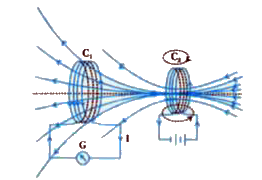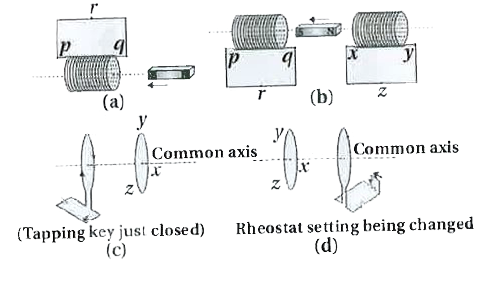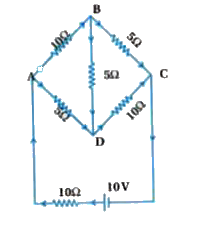
Consider Experiment:
(a) What would you do to obtain a large deflection of the galvanometer ?
(b) How would you demonstrate the presence of an induced current in the absence of a galvanometer ?Solution in Gujrati
(a) Following are different ways to increase the deflection in the galvanometer.
(i) We can increase no. of turns of a coil. (ii) We can have turns of a coil with greater area.
(iii) We can keep ferromagnetic core at the centre of coil.
(iv) We can increase the speed of bar mag net shown in experiment 6.2.
(b) We can replace galvanometer by a small bulb. Whenever induced current flows through this bulb, it glows which indirectly proves the existence of induced current.
Topper's Solved these Questions
- BOOK - KUMAR PRAKASHANCHAPTER - ELECTROMAGNETIC INDUCTIONEXERCISE - Section B (Numerical) Numerical From Textual Exercise17videos
ELECTROMAGNETIC INDUCTION
- BOOK - KUMAR PRAKASHANCHAPTER - ELECTROMAGNETIC INDUCTIONEXERCISE - Section B (Numerical) Numerical From DARPAN Based on Textbook10videos
ELECTROMAGNETIC INDUCTION
- BOOK - KUMAR PRAKASHANCHAPTER - ELECTROMAGNETIC INDUCTIONEXERCISE - Section A HOTS2videos
ELECTROMAGNETIC INDUCTION
- BOOK - KUMAR PRAKASHANCHAPTER - ELECTRIC CHARGES AND FIELDS EXERCISE - SECTION D MCQS ASKED IN COMPETITIVE EXAMES (MCQS AKSED IN BOARD EXAM AND GUJCET)14videos
ELECTRIC CHARGES AND FIELDS
- BOOK - KUMAR PRAKASHANCHAPTER - ELECTROMAGNETIC WAVESEXERCISE - BOARD.S QUESTION PAPER MARCH - 2020 (PART - B) SECTION - C5videos
ELECTROMAGNETIC WAVES
Similar Questions
Predict the direction of induced current in the situations described by the following figures (a) to (d).
 03:06View Solution
03:06View SolutionA conducting circular loop is placed in a uniform magnetic field of 0.04 T with its plane perpendicular to the field. Some how, the radius of the loop starts shrinking at a constant rate of 2 mm/s. Find the induced emf in the loop at an instant when the radius becomes 2 cm solution.
04:59View SolutionGive the explanation of reason behind the origin of motional induced emf.
01:16View SolutionWhen air is replaced by dielectric medium of constant K, the maximum force of attraction between two charges separated by distance d, ..........
02:57View SolutionDetermine the current in each branch of the given network.
 02:45View Solution
02:45View SolutionConsider Experiment 2, Art. 4(a). 3, (a) What would you do to obtain a large deflection of the galvanometer ? (b) How would you demonstrate the presence of an induced current in the absence of a galvanmeter ?
03:23View SolutionConsider experiment 6.2 (a) What would you do to get more deflection in the dielectric? (b) How would you indicate the presence of an induced current in the absence of a thermometer?
02:53View SolutionWhat would you do to obtain a large deflection of the galvanometer?
View SolutionHow would you demonstrate the presence of an induced current in the absence of a gal-vanometer ?
View Solutionफैराडे एवं हेनरी के प्रयोग संख्या दो में विचार करके बताइए -
धारामापी की अनुपस्थिति में आप प्रेरित धारा की उपस्थिति किस प्रकार दर्शाएँगे ?03:23View SolutionConsider Experiment II in Section 6.2.
a. What would you do to obtain a large deflection of the galvanometer?
b. How would you demonstrate the presence of an induced current in the absence of a galvanometer?04:44View SolutionConsider Experiment 6.2. (a) What would you do to obtain a large deflection of the galvanometer? (b) How would you demonstrate the presence of an induced current in the absence of a galvanometer?
04:56View SolutionConsider Experiment 6.2. (a) What would you do to obtain a large deflection of the galvanometer? (b) How would you demonstrate the presence of an induced current in the absence of a galvanometer?
01:42View SolutionConsider Experiment 6.2. (a) What would you do to obtain a large deflection of the galvanometer? (b) How would you demonstrate the presence of an induced current in the absence of a galvanometer?
01:13View SolutionConsider Experiment II in Section 6.2.
a. What would you do to obtain a large deflection of the galvanometer?
b. How would you demonstrate the presence of an induced current in the absence of a galvanometer?04:19View Solution

